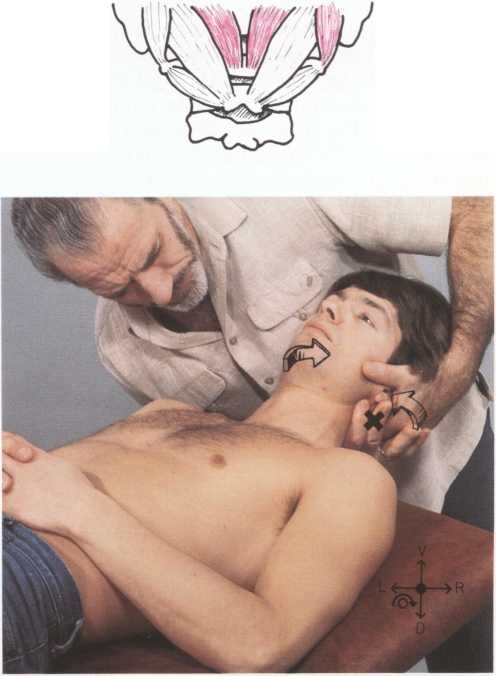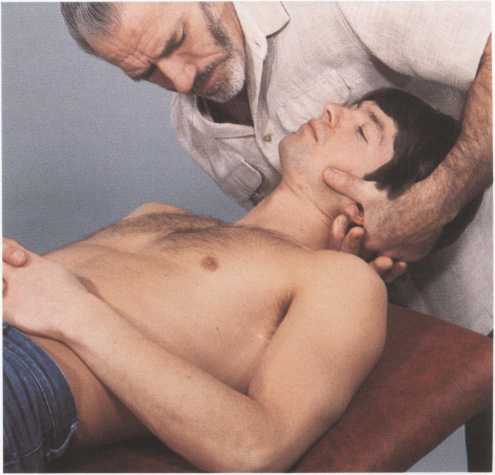75 (197)

3.8.1C. Specific techniąue to increase rota-tion to the right and lateral flexion to the left of the occiput on the atlas.
P supine.
Starting Position: P: Supine; head beyond end of couch with the atlas positioned at couch edge; shoulders and thorax may be stabilized with a belt. T: Standing at head of couch, to the right of P’s head.
Grip: The tip of T’s right index finger stabilizes the ventral aspect of the left transverse process of P’s atlas, preventing it from rotating to the right.
The rest of T’s right index finger and thumb lie along the posterior arch of P’s atlas. T’s left hand grips the left side of P’s occiput, stabilizing P's head against T’s chest and left shoulder. P's left ear should lie comfortably in the palm of T’s left hand. and T’s arm should be positioned to prevent uncomfortable pressure on P’s mandible.
Procedurę: Using this grip, T applies traction, and then maintaining this traction, gradually and fully rotates to the right and laterally flexes P’s occiput on the atlas to the left. T stabilizes P's atlas from the ventral aspect with the right index finger and from the dorsal aspect with the right thumb, thus allowing the occipital condyles to glide and rotate to the right on the atlas.
Stimulation of Antagonists: T retains grip, and asks P to look upwards, to the right, and rearwards, and then move his/her head further in the direction just stretched. T resists that move-ment to stimulate P’s antagonists.
Notę: This techniąue (with P supine) is among the morę difficult for therapists to master. Therefore, it is best to use the previous techniąues, 3.8.1A and 3.8.IB, pp. 73 and 74, with P sitting, whenever possible, because of their simplicity and effectiveness.

Fig. 59 a. Starting Position.

Fig. 59 b. Finał Position.
75
Wyszukiwarka
Podobne podstrony:
77 (197) 3.9.IB. Specific techniąue to increase rota-tion to the right of the atlas on the axis. Tra
66 (237) 3.7.1C. Non-specific techniąue to increase dorsal flexion with rotation to the right a
72 (211) 3.8.1A. Specific techniąue to increase rota-tion to the right and lateral flexion to the le
73 (201) Specific techniąue to increase rota-tion to the right and lateral flexion to the left of th
74 (202) 3.8.1B2. Specific technique to increase rota-tion to the right and lateral flexion to the l
64 (250) 3.7.1A. Non-specific technique to increase dorsal flexion with rotation to the right a
65 (245) 3.7.IB. Non-specific techniąue to increase dorsal flexion with rotation to the right a
67 (234) 3.7.2A1. Specific technique to increase dorsal flexion with rotation to the right and
68 (230) 3.7.2A2. Specific techniąue to increase dorsal flexion with rotation to the right and
69 (224) 3.7.2B. Specific techniąue to increase dorsal flexion with rotation to the right and l
71 (223) 3.7.2D. Specific techniąue to increase dorsal flexion with rotation to the right and l
70 (226) 3.7.2C. Specific techniąue to łncrease dorsal flexion with rotation to the right and l
40 (459) 3.3.1C. Non-specific techniąue to increase ventral flexion with rotation and lateral f
58 (289) 3.6.1A. Non-specific techniąue to increase dorsal flexion with rotation and later-al flexio
60 (278) 3.6.2A. Specific technique to increase dorsal flexion with rotation and lateral flex-ion to
61 (265) 3.6.2B. Specific techniąue to increase dorsal flexion with rotation and lateral flex-ion to
62 (263) 3.6.2C. Specific techniąue to increase dorsal flexion with rotation and lateral flex-ion to
63 (253) 3.6.2D. Specific technique to increase dorsal flexion with rotation and lateral flex-ion to
30 (655) 3.2.1. Non-specific techniąue to increase ventral flexion. Starting Position: P: Supine; he
więcej podobnych podstron